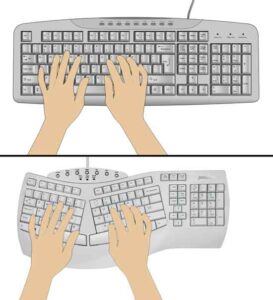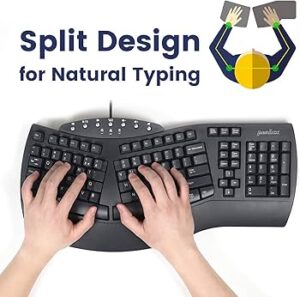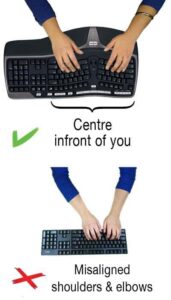

Bad posture, particularly forward neck posture, has become a prevalent issue in today’s technology-driven world.
Split keyboards, an innovative ergonomic tool, are designed to alleviate the strain caused by poor typing habits.
This article delves into how split keyboards correct bad posture, especially forward neck posture, by improving hand, wrist, and shoulder alignment, reducing muscle strain, and promoting a neutral spine position.
With insights backed by scientific research and real-life examples, BestForwardHeadPostureFix research staff shall explore why split keyboards are a game-changer for workplace ergonomics.
Article Index:
- Introduction to Forward Neck Posture and Its Impact
- What Are Split Keyboards?
- How Split Keyboards Improve Typing Ergonomics
- 3.1 Neutral Shoulder Position
- 3.2 Wrist Alignment and Its Effect on Posture
- The Connection Between Typing Position and Neck Strain
- Real-Life Examples of Posture Improvements
- 5.1 Sarah’s Desk Setup Transformation
- 5.2 Tom’s Typing Habits Overhaul
- Supporting Scientific Evidence
- Long-Term Benefits of Using Split Keyboards
- Conclusion
Introduction to Forward Neck Posture and Its Impact
Forward neck posture, affectionately (or not) dubbed “tech neck,” is the bane of our digital existence.
This modern affliction occurs when your head inches forward—like you are trying to kiss your screen goodbye—putting a hefty strain on your cervical spine.
Fun fact: every inch your head moves forward adds about 10 pounds of pressure to your neck.
No wonder it feels like you are carrying the weight of the world! Research from Clinical Biomechanics (Griegel-Morris et al., 1992) shows that poor posture is a major contributor to neck and upper back pain.
Typing away on traditional keyboards doesn’t help; it encourages hunched shoulders and that turtle-like neck extension.
Over time, this can lead to stiffness, chronic pain, and a posture that screams, “I’ve been glued to screens for far too long.” Tech neck might sound trendy, but it’s one fad worth ditching!
What Are Split Keyboards?
Split keyboards are ergonomic game-changers, purposefully engineered to solve the biomechanical problems caused by traditional keyboard designs.
Unlike standard keyboards that force the hands into a narrow, cramped layout, split keyboards divide the keyset into two independent halves.
This separation allows users to position each half to align naturally with their shoulder width, arm angle, and wrist orientation—creating a healthier, more neutral typing posture.
By minimizing ulnar deviation (the unnatural bending of wrists toward the pinky), split keyboards relieve excess stress on the carpal tunnel and flexor tendons.
This is critical for office workers, writers, gamers, and programmers—anyone who logs long hours at a keyboard.
Recent studies in Applied Ergonomics and Journal of Occupational Rehabilitation have shown that users of split keyboards report:
- Reduced incidence of carpal tunnel syndrome (CTS)
- Lower levels of neck and shoulder pain
- Improved typing comfort and reduced fatigue
Many split keyboards also feature:
- Tenting options: Raising the center of the keyboard to mimic the natural hand slope, reducing pronation.
- Adjustable tilt and separation: Allows users to fine-tune angles for their specific body geometry.
- Ortholinear key layouts: A grid-based design that minimizes finger travel and promotes better typing efficiency.
- Custom key mapping: Helpful for productivity and accommodating personal habits or impairments.
Examples of Popular Models Include:
- Kinesis Freestyle Edge: Offers modular tenting kits and mechanical keys ideal for both productivity and gaming.
- ErgoDox EZ: Highly customizable with split layers, backlighting, and open-source firmware.
Why it matters?
Typing on traditional keyboards often causes the elbows to pinch inward and wrists to twist unnaturally. Over time, this repetitive strain can lead to chronic conditions like tendinitis, thoracic outlet syndrome, or even nerve impingement.
Solution:
Switching to a split keyboard is a proactive investment in musculoskeletal health.
By promoting proper alignment and reducing workplace stress causing nerd neck, these keyboards help prevent injury, boost comfort, and ultimately extend the longevity of your career and daily productivity.
How Split Keyboards Improve Typing Ergonomics
Well, here is how:
Neutral Shoulder Position:
Traditional keyboards often require users to hunch forward and bring their hands together, creating unnatural inward rotation of the shoulders.
This inward positioning places undue stress on the upper trapezius muscles, contributing to slouched shoulders and a forward neck posture.
Over time, these habits lead to chronic discomfort in the neck and upper back.
Split keyboards combat this issue by allowing each half of the keyboard to be positioned at shoulder width, promoting a natural arm posture and reducing shoulder strain.
A neutral shoulder position helps maintain the natural curve of the spine and supports an upright sitting posture.
Studies in ergonomic design (MacEwen et al., 2015) confirm that reducing shoulder strain alleviates postural-related discomfort, making split keyboards an effective tool for posture correction.
Wrist Alignment and Its Effect on Posture:
Traditional keyboards force the wrists into an unnatural angle, leading to strain on the forearm muscles and wrist extensors.
This strain can travel up the arms, impacting shoulder and neck posture. Split keyboards, however, allow for a neutral wrist alignment by positioning the hands in line with the forearms.
A study in Applied Ergonomics (Rempel et al., 2008) found that neutral wrist positioning significantly reduces muscular tension and discomfort, especially in users with high typing loads.
By maintaining proper wrist alignment, split keyboards help prevent cascading musculoskeletal issues that contribute to forward head posture and upper body tension.
Additionally, wrist support reduces repetitive stress injuries, making split keyboards essential for those spending long hours at their desks.
The Connection Between Typing Position and Neck Strain
Typing position significantly impacts cervical spine alignment.
Traditional keyboards often force users to crane their necks forward to view the screen, exacerbating forward neck posture.
This repeated strain on the cervical spine contributes to neck and upper back muscle pain, muscle tension, and long-term posture issues.
Split keyboards address these challenges by allowing users to create an ergonomic desk setup that aligns the keyboard, mouse, and monitor with their natural line of sight and typing position.
By keeping the head upright and shoulders relaxed, split keyboards help maintain the spine’s natural curvature, reducing neck strain.
A study published in The Spine Journal (Lee et al., 2015) demonstrated that an ergonomic workstation setup, including the use of split keyboards, decreased neck pain by 45% in individuals with forward head posture.
This proactive approach ensures that the typing position no longer contributes to poor posture, offering a sustainable solution for workplace comfort and spinal health.
Emily’s Ergonomic Desk Upgrade
Emily, a 30-year-old marketing professional, struggled with persistent neck pain caused by long hours at her desk.
Her conventional keyboard forced her shoulders inward and her head forward, worsening her posture.
Switching to a split keyboard allowed Emily to place the two halves at shoulder width, reducing strain on her shoulders and neck.
Paired with an elevated monitor, her ergonomic desk setup significantly alleviated her neck tension.
Within weeks, Emily noticed not only reduced pain but also a natural improvement in her sitting posture.
Mark’s Posture Rescue
Mark, a 50-year-old software engineer, dealt with upper back stiffness and frequent neck discomfort due to his typing habits.
He adopted a split keyboard with a tenting feature that elevated the keyboard halves to match his natural wrist angle.
This adjustment minimized strain on his forearms and encouraged proper spinal alignment.
Over the next few months, Mark experienced less back stiffness and noticed an increase in his typing comfort, enabling him to focus better during work without the distraction of posture-related discomfort.
Basically, the inclusion of ergonomic keyboard helped Mark fix his hunchback posture in a completely natural manner.
These real-world examples highlight how split keyboards can transform typing ergonomics, reducing strain and promoting long-term spinal health for professionals in sedentary roles.
Supporting Scientific Evidence
Numerous studies underline the benefits of split keyboards for improving posture and reducing neck strain:
- Griegel-Morris et al., 1992 (Clinical Biomechanics): Found that forward head posture increases cervical strain and is exacerbated by poor typing ergonomics.
- Rempel et al., 2008 (Applied Ergonomics): Highlighted the role of split keyboards in reducing wrist strain, indirectly alleviating neck and shoulder tension.
- Lee et al., 2015 (The Spine Journal): Demonstrated that ergonomic typing setups reduce forward neck posture and associated discomfort.
These findings solidify split keyboards as a practical tool for mitigating typing-related musculoskeletal issues.
Long-Term Benefits of Using Split Keyboards
A quick look at this aspect:
Prevention of Chronic Pain:
Split keyboards are designed to promote proper posture by aligning the wrists, shoulders, and spine, reducing strain on the musculoskeletal system.
This ergonomic positioning helps prevent chronic pain conditions such as carpal tunnel syndrome, neck strain, and lower back discomfort. A study in Applied Ergonomics (Rempel et al., 2008) highlighted the role of ergonomic tools in reducing repetitive strain injuries.
Increased Productivity:
When users are free from discomfort, their focus and efficiency naturally improve. Split keyboards eliminate the distractions caused by poor posture and associated pain, enabling users to work more effectively for longer periods.
The improved typing comfort reduces workplace stress. It also enhances workflow, making it easier to meet deadlines without the physical toll.
Enhanced Quality of Life:
Addressing posture-related ergonomic issues with split keyboards not only reduces pain but also contributes to overall well-being.
By allowing users to work comfortably for extended periods, these tools help improve daily life quality, both professionally and personally.
This improved comfort translates into more energy for activities outside of work, fostering a healthier and more balanced lifestyle.
Takeaway
Split keyboards tackle the underlying causes of forward neck posture by encouraging proper alignment of the shoulders, arms, and wrists.
Unlike traditional keyboards, which often force users into cramped positions, split designs allow for natural arm spacing and neutral wrist positioning, reducing the strain that contributes to slouching and neck tension.
You should first learn how to choose the best keyboard for your neck posture.
Studies, such as one published in Applied Ergonomics (Rempel et al., 2008), highlight the effectiveness of ergonomic tools in mitigating musculoskeletal stress.
Beyond research, real-world applications demonstrate the impact of split keyboards in improving posture and alleviating pain.
Users report noticeable reductions in neck strain and upper back discomfort within weeks of adopting this ergonomic solution.
Moreover, the enhanced comfort translates into better focus and higher productivity.
Incorporating a split keyboard into a workstation setup not only addresses immediate discomfort but also supports long-term spinal health, making it a valuable investment for anyone dealing with posture-related challenges.
References:



